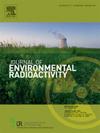GATE MARIM DB, a Monte Carlo database for dose assessment of microorganisms exposed to natural α-radioactivity
IF 1.9
3区 环境科学与生态学
Q3 ENVIRONMENTAL SCIENCES
引用次数: 0
Abstract
The International Commission on Radiological Protection (ICRP) recommended in 2007 a systematic approach to assess the radiological effects on non-human species. This method transforms radiation exposure into dose rates for living matter, using Dose Conversion Coefficients (DCCs) specific to radionuclides and organisms. Among the long-lived radionuclides, those of the 238U and 232Th decay chains dominate in terms of contributing to natural radiation exposure of non-human species, with significant dose contribution due to their alpha emissions. The ERICA tool was designed to assess dose rates for living organisms weighing from 10-6 kg to 103 kg. This study extends ERICA’s applicability by using the open-source GATE Monte Carlo platform to compute DCCs for smaller microorganisms exposed to alpha particles (internal or external exposures). This research compares GATE’s results to ERICA’s near its validity limits and explores how DCCs evolve with environmental composition and microorganism size. The open-source GATE MARIM database, including DCC values for 15 alpha-emitting isotopes from the 238U and 232Th decay chains, is now available with a Python Jupyter notebook interface enabling the calculation of dose rates for microorganisms exposed to natural radioactivity.
GATE MARIM DB,一个蒙特卡罗数据库,用于微生物暴露于天然α-放射性的剂量评估
国际放射防护委员会(ICRP)在2007年建议采用一种系统的方法来评估辐射对非人类物种的影响。该方法利用放射性核素和生物体特有的剂量转换系数(dcc),将辐射照射转化为生物物质的剂量率。在长寿命的放射性核素中,238U和232Th衰变链的核素对非人类物种的自然辐射暴露的贡献占主导地位,其α辐射对剂量的贡献很大。ERICA工具设计用于评估体重在10-6 kg至103 kg之间的活生物体的剂量率。本研究通过使用开源的GATE蒙特卡罗平台来计算暴露于α粒子(内部或外部暴露)的较小微生物的dcc,扩展了ERICA的适用性。本研究将GATE的结果与ERICA的结果进行了比较,并探讨了dcc如何随着环境成分和微生物大小的变化而变化。开源的GATE MARIM数据库,包括来自238U和232Th衰变链的15种α -发射同位素的DCC值,现在可以通过Python Jupyter笔记本界面计算暴露于自然放射性的微生物的剂量率。
本文章由计算机程序翻译,如有差异,请以英文原文为准。
求助全文
约1分钟内获得全文
求助全文
来源期刊

Journal of environmental radioactivity
环境科学-环境科学
CiteScore
4.70
自引率
13.00%
发文量
209
审稿时长
73 days
期刊介绍:
The Journal of Environmental Radioactivity provides a coherent international forum for publication of original research or review papers on any aspect of the occurrence of radioactivity in natural systems.
Relevant subject areas range from applications of environmental radionuclides as mechanistic or timescale tracers of natural processes to assessments of the radioecological or radiological effects of ambient radioactivity. Papers deal with naturally occurring nuclides or with those created and released by man through nuclear weapons manufacture and testing, energy production, fuel-cycle technology, etc. Reports on radioactivity in the oceans, sediments, rivers, lakes, groundwaters, soils, atmosphere and all divisions of the biosphere are welcomed, but these should not simply be of a monitoring nature unless the data are particularly innovative.
 求助内容:
求助内容: 应助结果提醒方式:
应助结果提醒方式:


